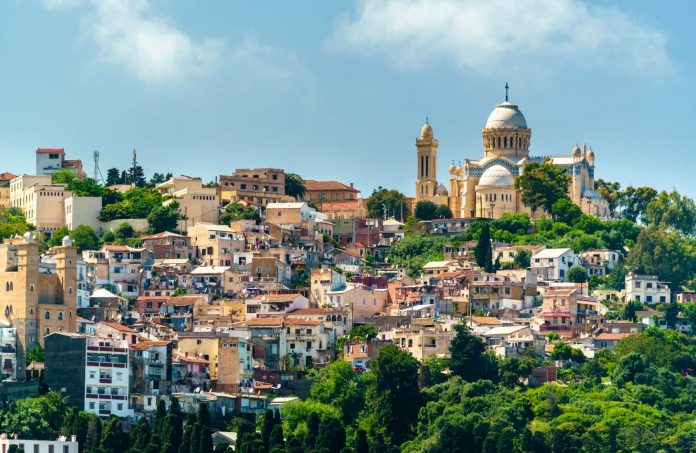
Contents
- 1 - The Casbah
- 2 - The Palais des Rais
- 3 - The Martyrs’ Memorial Monument
- 4 - Le Musee National Des Beaux-Arts (The National Museum of Fine Arts)
- 5 - Dar Abd-el-Tif
- 6 - Notre Dame d’Afrique
- 7 - The Ketchaoua Mosque
- 8 - The Museum of Modern Art (MAMA)
- 9 - The Great Mosque of Algiers (Djamaa el Djazaïr)
- 10 - The Central Post Office (La Grande Poste)
- 11 - La Rue Didouche Mourad
Last Updated on 13th June 2022
The capital city of Algeria is Algiers, which is also called Algiers the White. It’s one of the major cities in the Mediterranean. Algiers is the perfect start to a trip in Algeria, with its hectic streets, whitewashed buildings and breathtaking views. You can easily spend 2 to 3 full days in the city, as there are plenty of things to do here.
Algiers is honestly one of the most underrated capitals in the world, the city is a real gem.
Here is a list of iconic landmarks and places to visit in Algiers to make your trip memorable:
The Casbah
One of the most unique places in Algeria is the Casbah of Algiers. The Casbah was built in the 16th to 18th century- it’s a maze of streets overlooking the Mediterranean sea along the hills.
Today, the Casbah is the traditional and historical heart of the city. Many handicraft shops and local artists are found here.
Added as a UNESCO World Heritage site in 1992, you can spend a full day exploring the streets of Casbah. The closest metro station near this site is Place des Martyrs.
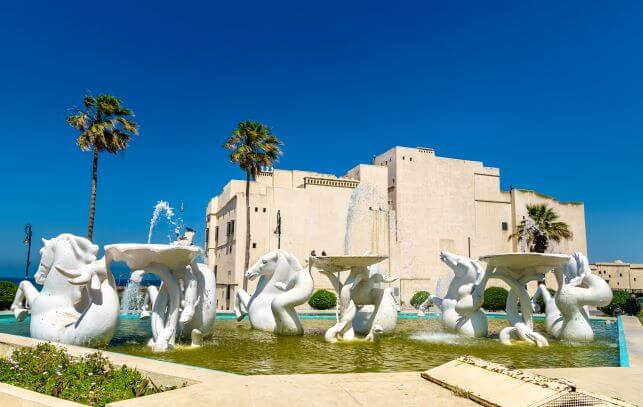
The Palais des Rais
The Palais des Rais, also known as Bastion 23, is one of the most Instagrammable places to visit in Algiers. The complex was built in the 16th century and is one of the last remaining quarters of the lower Casbah.
The Palais des Rais was completely isolated and detached from the Casbah following the restructuring during the French era.
This gorgeous complex is considered one of the most important historical monuments of the city and consists of three palaces and six houses.
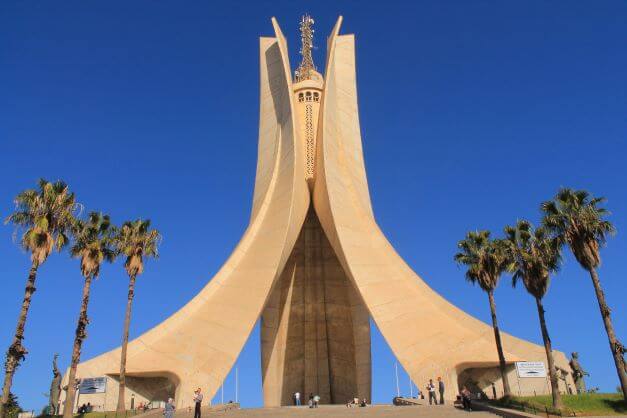
The Martyrs’ Memorial Monument
One of the best places to visit in Algiers and Algeria is the Martyrs’ Memorial Monument. The monument is found on the hills overlooking the city. If you had to choose one site to visit during your visit in Algiers, the Martyrs’ Memorial Monument is the one.
The monument is located above the Garden Hamma and Le Musee National Des Beaux-Arts.
Built in 1982, the monument has a height of 92 metres (302 feet) and is easy to spot from just about anywhere in the city. The monument was built to commemorate the Algerians that lost their lives during the Algerian war against the French for independence between 1954 and 1962.
There are plenty of artefacts from the war on display in the museum. However, the taking of photos within the museum is prohibited. The closest metro station near the museum is Jardin d’Essais.
Le Musee National Des Beaux-Arts (The National Museum of Fine Arts)
Le Musee National De Beaux-Arts has several floors: the first and second floors are filled with sculptures and statues, while the top floor is filled with older paintings and art.
Even if you’re not a huge art buff, it’s still worth visiting the museum for the stunning views of Algiers from the balcony.
After Algeria gained its independence in 1962, a shipment of 300 art pieces were brought to the Louvre in Paris. The art pieces included works by Courbet, Monet, Delacroix and others.
Over the years there have been negotiations between Algeria and France over the returning of the art pieces- which has been a contentious issue, causing an outrage in Algeria. The closest metro to the museum is the Jardin d’Essais.
Dar Abd-el-Tif
Located near the National Museum of Fine Arts, Dar Abd-el-Tif is another historical monument and Moorish house.
The house was once a residence to notables of the Casbah during the Ottoman era. During the French occupation, the villa housed many famous personalities and artists.
Today, the house is home to the Institute of Cultural Evolution. So, don’t be surprised if there’s a live concert taking place when you arrive.
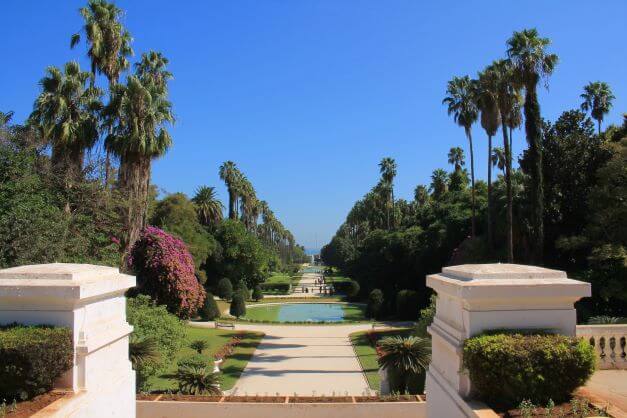
Jardin d’Essai (Botanical Garden Hamma)
The Botanical Garden Hamma, known as Jardin d’Essai, is a nice and quiet break from the busy streets of Algiers.
The garden was created from reclaimed marshland in 1832 as a test garden and model farm. Today, Garden Hamma remains a place for plant conservation, the collection and study of plant specimens, and environmental public education.
The Garden Hamma has even been used as a filming location in the 1930s for Tarzan of the Apes.
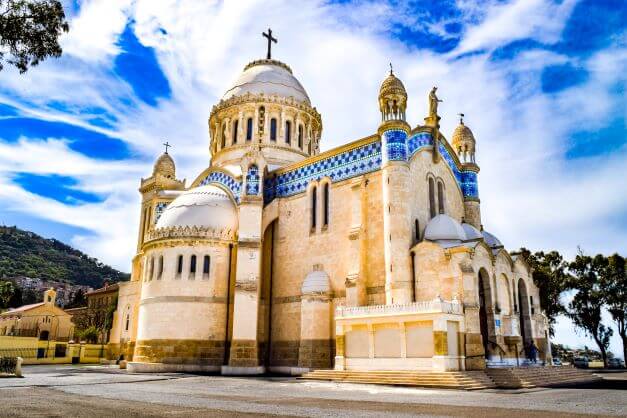
Notre Dame d’Afrique
One of the most famous landmarks of Algiers is Notre Dame d’Afrique, was built back in 1872 and is a Roman Catholic Church. The Notre Dame d’Afrique is located on a cliff overlooking the Bay Of Algiers, and is one of the most well-known landmarks in the city. The landmark also offers a great view over the Bab El Oued neighbourhood.
The famous words that are carved behind the altar of the landmark are “Notre Dame d’Afrique priez pour nous et pour les Musulmans”, which is French for “Our Lady of Africa, pray for the Muslims and for us”.
There isn’t a metro nearby, so use a taxi instead.
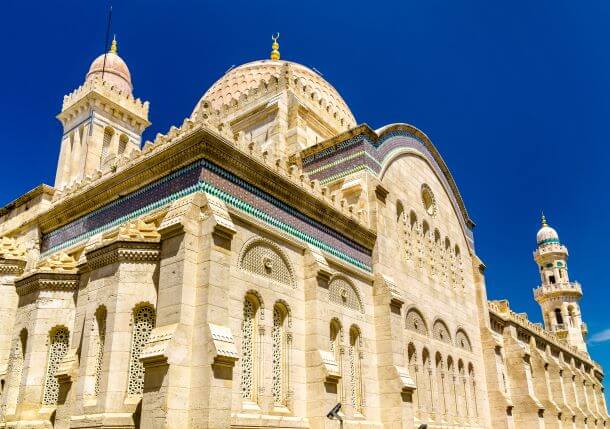
The Ketchaoua Mosque
Built in 1612, the Ketchaoua Mosque was built during the rule of the Ottoman Empire. Then, in 1845 it was turned into the cathedral of Saint Philippe by the French. After Algeria got its independence, it once again became a Mosque in 1962.
Today, the Ketchaoua Mosque is one of the best-preserved historical buildings in the city. It has a strategic location on the first stairways of the Casbah.
The Museum of Modern Art (MAMA)
The Museum of Modern Art is a great place to visit as the museum gives you an insight into the work of local artists.
MAMA hosts many exhibitions throughout the year, consisting of photography, painting and drawing. The gallery focuses on both famous and emerging artists alike.
The museum is an elegant Neo-Moorish building which was once a department store, known as Galeries de France.
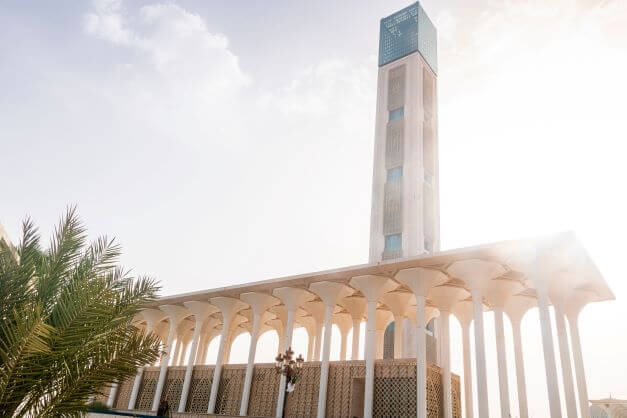
The Great Mosque of Algiers (Djamaa el Djazaïr)
In 2019, the Great Mosque of Algiers was completed after seven years of construction.
Known to locals as Djamaa el Djazïr, the great mosque broke new world records and is recognized today as the third largest mosque in the world and the largest mosque on the African continent.
Its minaret stands at 265 metres (869 feet), which makes it the world’s tallest minaret.
The Central Post Office (La Grande Poste)
Known as La Grande Poste, the Central Post Office is one of the most beautiful and iconic monuments in all of Algiers.
Its building is a fine example of early 20th century French-designed and Moorish architecture. The ceiling is decorated with stunning mosaics inside the building.
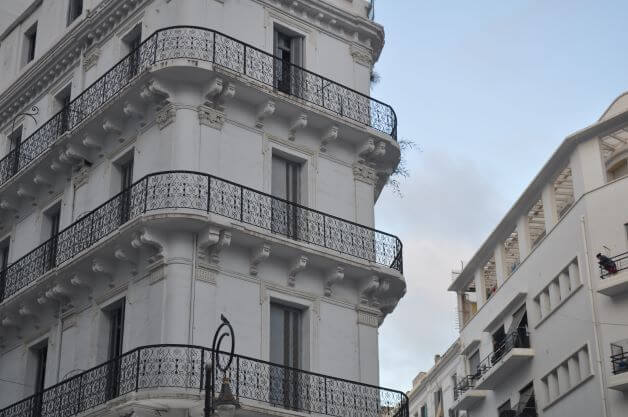
La Rue Didouche Mourad
Walking through La Rue Didouche Mourad may be the best thing for you if you are passionate about the Haussmann style of architecture.
Built by the end of the 1900s, La Rue Didouche Mourad offers plenty of historical knowledge about Algiers and has extensive places to see.
This area is a great place to shop for traditional handicrafts and for souvenirs. The architecture is French-inspired and absolutely beautiful- it can only be described as a magical place to visit and see locals carry out their daily activities.
Although the variety is limited, there are plenty of restaurants and cafes that will give you a taste of their delicious cuisine.
































